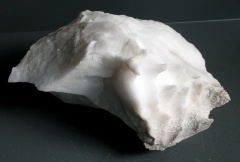Alabaster
| Infobox on Alabaster | |
|---|---|
| Example of Alabaster |  |
| Facts | |
| Origin | Most continents |
| Stowage factor (in m3/t) |
|
| Humidity / moisture | - |
| Ventilation | - |
| Risk factors | Moisture damage, weight loss and contamination/defilement. |
Alabaster
Description
Alabaster is a name applied to varieties of two distinct minerals, when used as a material: gypsum (a hydrous sulfate of calcium) and calcite (a carbonate of calcium). The latter is the alabaster of the present day; generally, the former is the alabaster of the ancients. Both are easy to work, with an attractive appearance, and have been used for making a variety of artworks and objects, especially small carvings.
The two kinds are distinguished from one another readily, because of differences in their relative hardness. The gypsum kind is so soft as to be readily scratched with a fingernail (Mohs hardness 1.5 to 2), while the calcite kind is too hard to be scratched in this way (Mohs hardness 3), although it does yield readily to a knife. Moreover, the calcite alabaster, being a carbonate, effervesces upon being touched with hydrochloric acid, whereas the gypsum alabaster, when thus treated, remains practically unaffected.
Due to the characteristic color of white alabaster, the term has entered the vernacular as a metonym for white things, particularly "alabaster skin", which means very light and quite transparent, and possibly derives from the use of alabaster for tomb effigies.
Calcite alabaster
This substance, the "alabaster" of the Ancient Egyptians and Bible, often is termed Oriental alabaster, since the early examples came from the Far East.
When cut in thin sheets, alabaster is translucent enough to be used for small windows. It was used for this purpose in medieval churches, especially in Italy.
Calcite alabaster is found as either a stalagmitic deposit, from the floor and walls of limestone caverns, or as a kind of travertine, similarly deposited in springs of calcareous water. Its deposition in successive layers gives rise to the banded appearance that the marble often shows on cross-section, whence it is known as onyx-marble or alabaster-onyx, or sometimes simply as onyx. The latter term should be restricted to siliceous minerals, however.
Gypsum alabaster
When the term "alabaster" is used without any qualification, it invariably means a fine-grained variety of gypsum.
Gypsum alabaster is a common mineral, which occurs in England.
In Europe, the centre of the alabaster trade today is Florence, Italy. Tuscan alabaster occurs in nodular masses embedded in limestone. The mineral is worked largely by means of underground galleries, in the district of Volterra. Several varieties are recognized—veined, spotted, clouded, agatiform, and others. The finest kind, obtained principally from Castellina, is sent to Florence for figure-sculpture, while the common kinds are carved locally, into vases, lights, and various ornamental objects. These items are objects of extensive trade, especially in Florence, Pisa, and Livorno. Spain and many other countries have deposits which have been worked.
Applications
The finer kinds of alabaster are employed largely as an ornamental stone, especially for ecclesiastical decoration and for the rails of staircases and halls. Its softness enables it to be carved readily into elaborate forms, but its solubility in water renders it unsuitable for outdoor work. If alabaster with a smooth, polished surface is washed with washing-up liquid (dishwashing liquid), it will become rough, dull and whiter, losing most of its translucency and lustre.
The purest alabaster is a snow-white material of fine tiniforni grain, but it often is associated with an oxide of iron, which produces brown clouding and veining in the stone. The coarser varieties of alabaster are converted by calcination into plaster of Paris, whence they sometimes are known as "plaster stone."
In order to diminish the translucency of the alabaster and to produce an opacity suggestive of true marble, the statues are immersed in a bath of water and heated gradually—nearly to the boiling-point—an operation requiring great care, for if the temperature is not regulated carefully, the stone acquires a dead-white, chalky appearance. The effect of heating appears to be a partial dehydration of the gypsum. If properly treated, it very closely resembles true marble and is known as marmo di Castellina.
Sulphate of lime (gypsum) also was used by the ancients. It was employed, for instance, in Assyrian sculpture. So some of the ancient alabaster is identical to the modern stone.
Alabaster may be stained to disguise it, by being heated in various pigmentary solutions. In this way a very misleading imitation of coral that is called alabaster coral is produced.
Shipment/storage
Alabaster is a fine grained white colored stone of brittle nature. The product is shipped as blocks or bulk. It can give off moisture and therefore lose weight.
Risk factors
- Moisture dame
- Weight loss
- Contamination/defilement











